Connect With Us
Blog

Ankle pain when walking can have several causes, ranging from injury to underlying medical conditions. Common injuries like sprains or strains occur when ligaments or muscles in the ankle are overstretched or torn, often from twisting or rolling the ankle. Ankle bruising, fractures, or breaks can also result in significant discomfort, especially when weight is placed on the joint. Conditions such as osteoarthritis and gout can lead to chronic ankle pain. Osteoarthritis pain is the result of cartilage breakdown between the bones, while gout is inflammation caused by the buildup of uric acid crystals in the ankle joint. A podiatrist can diagnose the cause of ankle pain and offer appropriate treatment options. If you experience ankle pain when you walk, it is suggested that you schedule an appointment with a podiatrist for an evaluation and treatment.
Ankle pain can be caused by a number of problems and may be potentially serious. If you have ankle pain, consult with one of our podiatrists from Illinois . Our doctors will assess your condition and provide you with quality foot and ankle treatment.
Ankle pain is any condition that causes pain in the ankle. Due to the fact that the ankle consists of tendons, muscles, bones, and ligaments, ankle pain can come from a number of different conditions.
Causes
The most common causes of ankle pain include:
- Types of arthritis (rheumatoid, osteoarthritis, and gout)
- Ankle sprains
- Broken ankles
- Achilles tendonitis
- Achilles tendon rupture
- Stress fractures
- Bursitis
- Tarsal tunnel syndrome
- Plantar fasciitis
Symptoms
Symptoms of ankle injury vary based upon the condition. Pain may include general pain and discomfort, swelling, aching, redness, bruising, burning or stabbing sensations, and/or loss of sensation.
Diagnosis
Due to the wide variety of potential causes of ankle pain, podiatrists will utilize a number of different methods to properly diagnose ankle pain. This can include asking for personal and family medical histories and of any recent injuries. Further diagnosis may include sensation tests, a physical examination, and potentially x-rays or other imaging tests.
Treatment
Just as the range of causes varies widely, so do treatments. Some more common treatments are rest, ice packs, keeping pressure off the foot, orthotics and braces, medication for inflammation and pain, and surgery.
If you have any questions, please feel free to contact our offices located in Wheeling and Berwyn, IL . We offer the newest diagnostic and treatment technologies for all your foot care needs.
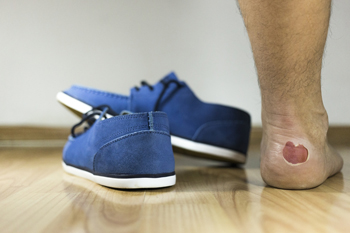
Blisters are common nuisances that can hinder an active lifestyle, but several effective prevention methods can help keep them at bay. One of the most important strategies is wearing properly fitted shoes that provide adequate support and cushioning. It is important to choose footwear that accommodates the shape of your feet, reducing friction and pressure points. Using moisture-wicking socks can also minimize the risk of blisters, as they help keep feet dry and reduce friction. Applying blister prevention products, such as protective adhesive bandages or lubricants, can create a barrier between the skin and footwear. Additionally, gradually breaking in new shoes allows your feet to adapt, reducing the likelihood of irritation. Foot blisters can be uncomfortable, causing difficulty in completing daily activities. If you have developed a foot blister that has become infected, it is suggested that you promptly consult a podiatrist who can provide adequate relief, and educate you on additional prevention methods.
Blisters may appear as a single bubble or in a cluster. They can cause a lot of pain and may be filled with pus, blood, or watery serum. If your feet are hurting, contact one of our podiatrists of Illinois . Our doctors can provide the care you need to keep you pain-free and on your feet.
Foot Blisters
Foot blisters are often the result of friction. This happens due to the constant rubbing from shoes, which can lead to pain.
What Are Foot Blisters?
A foot blister is a small fluid-filled pocket that forms on the upper-most layer of the skin. Blisters are filled with clear fluid and can lead to blood drainage or pus if the area becomes infected.
Symptoms
(Blister symptoms may vary depending on what is causing them)
- Bubble of skin filled with fluid
- Redness
- Moderate to severe pain
- Itching
Prevention & Treatment
In order to prevent blisters, you should be sure to wear comfortable shoes with socks that cushion your feet and absorb sweat. Breaking a blister open may increase your chances of developing an infection. However, if your blister breaks, you should wash the area with soap and water immediately and then apply a bandage to the affected area. If your blisters cause severe pain it is important that you call your podiatrist right away.
If you have any questions, please feel free to contact our offices located in Wheeling and Berwyn, IL . We offer the newest diagnostic and treatment technologies for all your foot care needs.
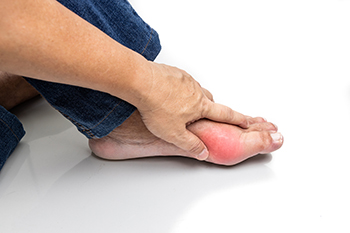
Gout is caused by an excess buildup of uric acid in the body, leading to the formation of sharp, needle-like crystals in the joints. Gout often affects the joint at the base of the big toe, resulting in sudden and severe pain, swelling, and redness. The affected area may feel warm, tender, and inflamed, making it difficult to put weight on the foot. These intense symptoms typically occur at night and can disrupt sleep. After the initial flare-up of gout, the extreme pain may subside, but discomfort and joint stiffness may persist for several days. Gout also may impact range of motion in the affected joint. Risk factors include a diet high in purine-rich foods, such as red meat and seafood, as well as excessive alcohol consumption and certain medications that raise uric acid levels. Other contributing factors include kidney disease, high blood pressure, and obesity. If you have symptoms of gout, it is suggested that you schedule an appointment with a podiatrist for a diagnosis and treatment options.
Gout is a painful condition that can be treated. If you are seeking treatment, contact one of our podiatrists from Illinois . Our doctors will treat your foot and ankle needs.
What Is Gout?
Gout is a form of arthritis that is characterized by sudden, severe attacks of pain, redness, and tenderness in the joints. The condition usually affects the joint at the base of the big toe. A gout attack can occur at any random time, such as the middle of the night while you are asleep.
Symptoms
- Intense Joint Pain - Usually around the large joint of your big toe, and it most severe within the first four to twelve hours
- Lingering Discomfort - Joint discomfort may last from a few days to a few weeks
- Inflammation and Redness -Affected joints may become swollen, tender, warm and red
- Limited Range of Motion - May experience a decrease in joint mobility
Risk Factors
- Genetics - If family members have gout, you’re more likely to have it
- Medications - Diuretic medications can raise uric acid levels
- Gender/Age - Gout is more common in men until the age of 60. It is believed that estrogen protects women until that point
- Diet - Eating red meat and shellfish increases your risk
- Alcohol - Having more than two alcoholic drinks per day increases your risk
- Obesity - Obese people are at a higher risk for gout
Prior to visiting your podiatrist to receive treatment for gout, there are a few things you should do beforehand. If you have gout you should write down your symptoms--including when they started and how often you experience them, important medical information you may have, and any questions you may have. Writing down these three things will help your podiatrist in assessing your specific situation so that he or she may provide the best route of treatment for you.
If you have any questions, please feel free to contact our offices located in Wheeling and Berwyn, IL . We offer the newest diagnostic and treatment technologies for all your foot care needs.
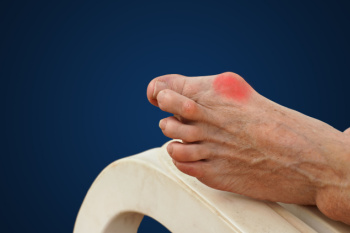
A bunion is a bony prominence that forms at the base of the big toe, often resulting from an imbalance in foot mechanics. Common causes include genetics, wearing tight or ill-fitting shoes, and certain foot conditions like arthritis. Symptoms typically include swelling, redness, and pain at the bunion site, along with difficulty in finding comfortable footwear. The big toe may also drift toward the other toes, increasing discomfort. To diagnose a bunion, a podiatrist will conduct a physical examination, assessing the foot's alignment and range of motion. X-rays may be ordered to evaluate the extent of the deformity and rule out other conditions. Early diagnosis is essential, as timely intervention can help manage symptoms and prevent the bunion from worsening, allowing individuals to maintain an active lifestyle without pain. If you have a bunion, it is suggested that you schedule an appointment with a podiatrist who can provide treatment.
If you are suffering from bunion pain, contact one of our podiatrists of Illinois . Our doctors can provide the care you need to keep you pain-free and on your feet.
What Is a Bunion?
Bunions are painful bony bumps that usually develop on the inside of the foot at the joint of the big toe. As the deformity increases over time, it may become painful to walk and wear shoes. Women are more likely to exacerbate existing bunions since they often wear tight, narrow shoes that shift their toes together. Bunion pain can be relieved by wearing wider shoes with enough room for the toes.
Causes
- Genetics – some people inherit feet that are more prone to bunion development
- Inflammatory Conditions - rheumatoid arthritis and polio may cause bunion development
Symptoms
- Redness and inflammation
- Pain and tenderness
- Callus or corns on the bump
- Restricted motion in the big toe
In order to diagnose your bunion, your podiatrist may ask about your medical history, symptoms, and general health. Your doctor might also order an x-ray to take a closer look at your feet. Nonsurgical treatment options include orthotics, padding, icing, changes in footwear, and medication. If nonsurgical treatments don’t alleviate your bunion pain, surgery may be necessary.
If you have any questions, please feel free to contact our offices located in Wheeling and Berwyn, IL . We offer the newest diagnostic and treatment technologies for all your foot care needs.
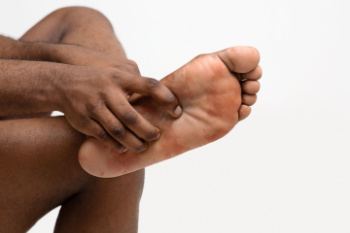
Plantar fasciitis is caused by inflammation of the plantar fascia, a ligament that runs from the heel to the ball of the foot, supporting the arch. The main symptoms of plantar fasciitis is sharp pain in the heel or arch that is often more severe in the morning or after prolonged standing. Heel pain may improve slightly after walking but often returns with continued activity. Risk factors for plantar fasciitis include flat feet, high arches, obesity, and repetitive activities like running. Tight calf muscles can also increase the likelihood of developing this condition. A podiatrist can evaluate your symptoms and recommend treatment options. Included are stretching exercises, footwear adjustments, and custom orthotics. Surgery may be suggested in more severe cases. If you have heel pain caused by plantar fasciitis, it is suggested that you schedule an appointment with a podiatrist for an exam and treatment.
Plantar fasciitis is a common foot condition that is often caused by a strain injury. If you are experiencing heel pain or symptoms of plantar fasciitis, contact one of our podiatrists from Illinois . Our doctors can provide the care you need to keep you pain-free and on your feet.
What Is Plantar Fasciitis?
Plantar fasciitis is one of the most common causes of heel pain. The plantar fascia is a ligament that connects your heel to the front of your foot. When this ligament becomes inflamed, plantar fasciitis is the result. If you have plantar fasciitis you will have a stabbing pain that usually occurs with your first steps in the morning. As the day progresses and you walk around more, this pain will start to disappear, but it will return after long periods of standing or sitting.
What Causes Plantar Fasciitis?
- Excessive running
- Having high arches in your feet
- Other foot issues such as flat feet
- Pregnancy (due to the sudden weight gain)
- Being on your feet very often
There are some risk factors that may make you more likely to develop plantar fasciitis compared to others. The condition most commonly affects adults between the ages of 40 and 60. It also tends to affect people who are obese because the extra pounds result in extra stress being placed on the plantar fascia.
Prevention
- Take good care of your feet – Wear shoes that have good arch support and heel cushioning.
- Maintain a healthy weight
- If you are a runner, alternate running with other sports that won’t cause heel pain
There are a variety of treatment options available for plantar fasciitis along with the pain that accompanies it. Additionally, physical therapy is a very important component in the treatment process. It is important that you meet with your podiatrist to determine which treatment option is best for you.
If you have any questions, please feel free to contact our offices located in Wheeling and Berwyn, IL . We offer the newest diagnostic and treatment technologies for all your foot care needs.
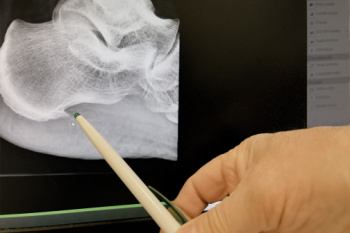
Heel spurs are bony growths that develop on the bottom or back of the heel. They are often associated with foot conditions like plantar fasciitis and Achilles tendonitis. When a spur forms on the bottom of the heel, it is typically linked to heel spur syndrome. This occurs where the plantar fascia, a band of tissue supporting the arches of the foot, connects to the heel bone. These heel spurs often develop due to stress, overuse, or some kind of injury to the heel area. Another common type is a dorsal spur. This forms at the back of the heel, where the Achilles tendon attaches. It is often the result of insertional Achilles tendonitis, or inflammation. While heel spurs are common, many people do not experience pain. However, those with symptoms may notice discomfort during walking or running. A podiatrist can diagnose the cause of your heel pain and provide custom orthotics that can help prevent further damage. If you believe you may have developed a heel spur, it is suggested that you schedule an appointment with a podiatrist for an exam and treatment.
Heel spurs can be incredibly painful and sometimes may make you unable to participate in physical activities. To get medical care for your heel spurs, contact one of our podiatrists from Illinois . Our doctors will do everything possible to treat your condition.
Heels Spurs
Heel spurs are formed by calcium deposits on the back of the foot where the heel is. This can also be caused by small fragments of bone breaking off one section of the foot, attaching onto the back of the foot. Heel spurs can also be bone growth on the back of the foot and may grow in the direction of the arch of the foot.
Older individuals usually suffer from heel spurs and pain sometimes intensifies with age. One of the main condition's spurs are related to is plantar fasciitis.
Pain
The pain associated with spurs is often because of weight placed on the feet. When someone is walking, their entire weight is concentrated on the feet. Bone spurs then have the tendency to affect other bones and tissues around the foot. As the pain continues, the feet will become tender and sensitive over time.
Treatments
There are many ways to treat heel spurs. If one is suffering from heel spurs in conjunction with pain, there are several methods for healing. Medication, surgery, and herbal care are some options.
If you have any questions feel free to contact our offices located in Wheeling and Berwyn, IL . We offer the latest in diagnostic and treatment technology to meet your needs.

An ankle sprain occurs when the ligaments that support the ankle are stretched or torn due to an injury. This common condition often results from activities that involve sudden twists, turns, or impacts, such as sports or missteps. The primary causes include rolling the ankle inward or outward, overextending it, or landing awkwardly. Symptoms of an ankle sprain typically include pain, swelling, bruising, and difficulty in moving the ankle. In severe cases, there may be instability or an inability to bear weight. Addressing an ankle sprain can help to manage symptoms and promote a quicker recovery. If you have sprained your ankle, it is suggested that you consult a podiatrist who can offer you treatment solutions.
Although ankle sprains are common, they aren’t always minor injuries. If you need your ankle injury looked at, contact one of our podiatrists from Illinois . Our doctors can provide the care you need to keep you pain-free and on your feet.
How Does an Ankle Sprain Occur?
Ankle sprains are the result of a tear in the ligaments within the ankle. These injuries may happen when you make a rapid shifting movement while your foot is planted. A less common way to sprain your ankle is when your ankle rolls inward while your foot turns outward.
What Are the Symptoms?
- Pain at the sight of the tear
- Bruising/Swelling
- Ankle area is tender to touch
- In severe cases, may hear/feel something tear
- Skin discoloration
Preventing a Sprain
- Wearing appropriate shoes for the occasion
- Stretching before exercises and sports
- Knowing your limits
Treatment of a Sprain
In many cases, the RICE method (Rest, Ice, Compression, and Elevate) is used to treat ankle sprains. However, you should see a podiatrist to see which treatment option would work best with your injury. In severe cases, surgery may be required.
It is important to ask your doctor about rehab options after you receive treatment for your injury. Stretching, strength training, and balance exercises may help the ankle heal while also preventing further injury.
If you have any questions, please feel free to contact our offices located in Wheeling and Berwyn, IL . We offer the newest diagnostic and treatment technologies for all your foot care needs.
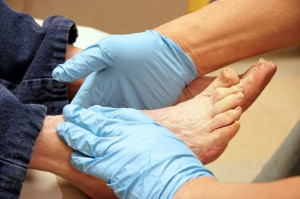
Foot problems are a common and serious concern for individuals with diabetes, often leading to complications like diabetic foot ulcers. Diabetes can cause nerve damage and poor blood circulation, making the feet more prone to injuries that might go unnoticed due to reduced sensation. The lack of feeling increases the risk of wounds, blisters, and ulcers, which can worsen without proper care. Diabetic foot ulcers can take a long time to heal and may lead to infections if not treated properly. Podiatrists play a vital role in managing diabetes related foot issues. They can perform necessary treatments, such as debridement to remove dead tissue, suggest appropriate footwear to alleviate pressure on affected areas, and provide wound care solutions. If you have a foot problem related to diabetes, it is suggested that you schedule an appointment with a podiatrist for regular monitoring and care.
Diabetic foot care is important in preventing foot ailments such as ulcers. If you are suffering from diabetes or have any other concerns about your feet, contact one of our podiatrists from Illinois . Our doctors can provide the care you need to keep you pain-free and on your feet.
Diabetic Foot Care
Diabetes affects millions of people every year. The condition can damage blood vessels in many parts of the body, especially the feet. Because of this, taking care of your feet is essential if you have diabetes, and having a podiatrist help monitor your foot health is highly recommended.
The Importance of Caring for Your Feet
- Routinely inspect your feet for bruises or sores.
- Wear socks that fit your feet comfortably.
- Wear comfortable shoes that provide adequate support.
Patients with diabetes should have their doctor monitor their blood levels, as blood sugar levels play such a huge role in diabetic care. Monitoring these levels on a regular basis is highly advised.
It is always best to inform your healthcare professional of any concerns you may have regarding your feet, especially for diabetic patients. Early treatment and routine foot examinations are keys to maintaining proper health, especially because severe complications can arise if proper treatment is not applied.
If you have any questions please feel free to contact our offices located in Wheeling and Berwyn, IL . We offer the newest diagnostic and treatment technologies for all your foot and ankle needs.
Blog Archives
- 2025
- 2024
- 2023
- 2022
- 2021
- 2020



